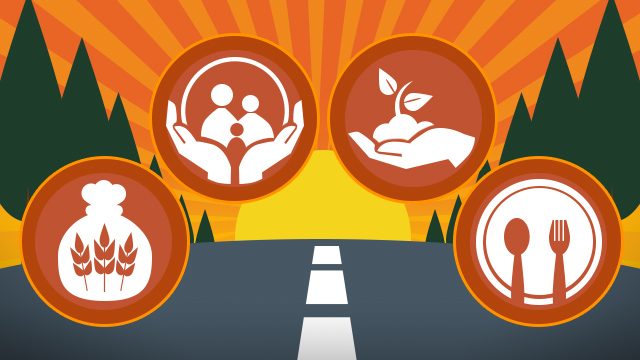SUMMARY
This is AI generated summarization, which may have errors. For context, always refer to the full article.

MANILA, Philippines – Despite the “positive” trends in global ratings against hunger, the fact remains that one in every 9 people still suffers from chronic hunger.
In the past decade, there has been significant progress when it comes to poverty and malnutrition. More than 100 million people have escaped the hunger and poverty trap, according to the World Food Programme (WFP), due to the “collective and combined efforts” of public and private stakeholders.
Unfortunately, several factors in recent years have hindered the “global momentum” for complete hunger mitigation. These include climate change, natural disasters, and discontinued investments in projects. (READ: What climate change means to the world’s hungry people)
During a global food crisis in 2009, the Roadmap to End Global Hunger (REGH) was developed by organizations and advocacy groups. The framework employed a US strategy to propagate food security worldwide.
Nearing the end of its initial 5-year timeline, the original signatories decided to update the REGH in February 2015. This was done to reaffirm the global calls for a more “comprehensive approach to a food secure world.”
Pillars against hunger
The latest anti-hunger roadmap features 4 pillars which explain what households and communities can do to achieve food security. This should be sustainable and invincible against factors that affected previous hunger mitigation efforts.
 Pillar 1: Emergencies
Pillar 1: Emergencies
Families and communities – regardless of their economic status – may be pulled down to food insecurity once emergencies such as typhoons and droughts arise. (READ: Food security amid a changing climate)
Their resilience therefore should be bolstered for them to withstand “shocks and setbacks” to their food and nutrition security. In addition, organizations should quickly address nutritional needs once these emergencies strike to prevent widespread hunger that may result in long-term problems.
In the Philippine context, the members of the near-poor sector should also be given priority in the different mitigation projects. (READ: Who are the near-poor in the Philippines?)
Based on data from the Annual Poverty Indicator Survey (APIS) from 2004 to 2010, 38.6% of total Filipino families are cyclical poor. Otherwise called balik-balik, these families are those who recover from poverty before suffering from it again in a given period of time.
The cyclical poor in the country are the most vulnerable to fall into the hunger trap during emergencies.
 Pillar 2: Safety Nets
Pillar 2: Safety Nets
Everyone is vulnerable to a sudden interruption in the ability to afford sufficient and nutritious food.
These interruptions come in different forms – loss of job, death in the family, sudden illness, disasters, and poor harvest, among others – so it is best that families are taught how to protect their productive assets.
This can be achieved by identifying the unique needs, assets, and priorities of each vulnerable sector. By doing so, the projects can effectively target and mitigate the problem.
The “safety nets” in the Philippines can be the Pantawid Pamilyang Pilipino Program (4Ps) – a program of the country’s welfare department. It aims to grant cash to families living in poverty to fulfill the needs for food and education expenses.
Its effectiveness has however been questioned given its annual budget allocation. (READ: Lawmakers question DSWD’s conditional cash transfer program)
 Pillar 3: Nutrition
Pillar 3: Nutrition
It is not enough that people eat. It is important that the food they eat provide the right nutrients for a person to function well.
However, it is also equally important to consider the nutritional requirements in each life stage. For example, the first 1,000 days of a child is the most important window for developments.
Meanwhile, an adult requires a much higher amount of energy intake for a day’s worth of workload.
The tailored requirements should be kept in mind from planning and budgeting to implementation and evaluation. (READ: Lifesaving 6: Saving mothers and children from malnutrition)
The Food and Nutrition Research Institute (FNRI)’s projects, Pinggang Pinoy and the Recommended Energy and Nutrition Intakes (RENI), serve as a guide not only for household meals but also for those involved in feeding programs.
Pillar 4: Agriculture
 According to the International Food Policy Research Institute (IFPRI), agriculture plays a big role in the fight against hunger in the world.
According to the International Food Policy Research Institute (IFPRI), agriculture plays a big role in the fight against hunger in the world.
The institute added that investing in this sector is the “most effective way” to reduce poverty and eventually, hunger.
Achieving this should not only focus on investing money. The natural resources in which agriculture depend on should be protected from abuse.
In addition, the capacity of small-scale food producers should be geared toward quick adaption to the unpredictable climate. (READ: Empowering farmers against climate change)
This is specifically important to the Philippines – one of the countries most affected by climate change. Unfortunately, Filipino food producers – farmers and fisherfolk – are among the poorest sector. (READ: PH agriculture: Why is it important?)
Towards resiliency
The changing climate is seen to be one of the biggest perpetrators of hunger and poverty.
For the succeeding generations to experience the “effects” of anti-hunger efforts, all actions aiming for food and nutrition security should be geared toward resiliency.
The Roadmap Coalition hopes that the latest pillars released can be of great help to stakeholders in different regions – regardless if it is a big organization, a small community, or even one household head. – Rappler.com
Add a comment
How does this make you feel?
There are no comments yet. Add your comment to start the conversation.